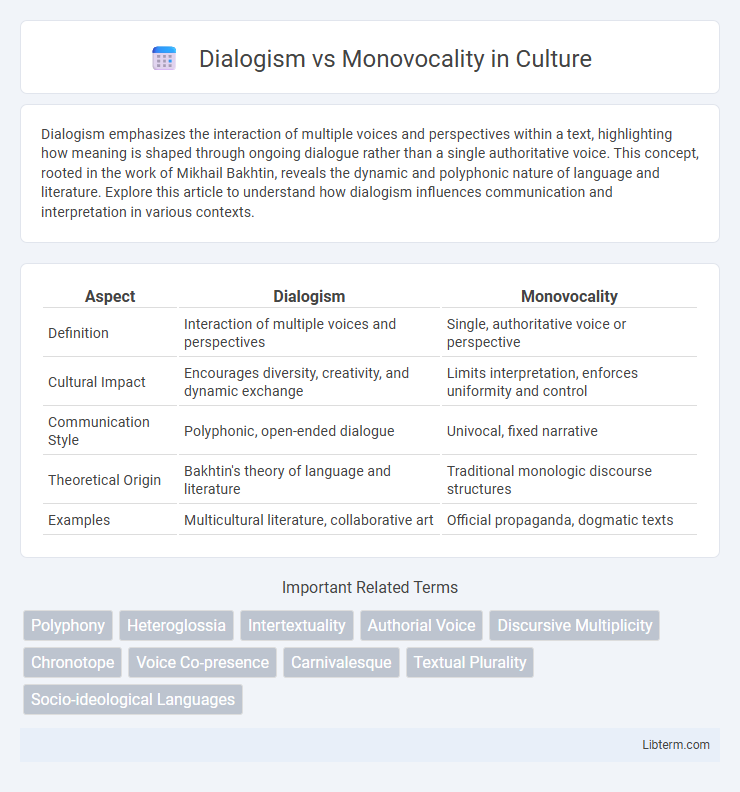Dialogism emphasizes the interaction of multiple voices and perspectives within a text, highlighting how meaning is shaped through ongoing dialogue rather than a single authoritative voice. This concept, rooted in the work of Mikhail Bakhtin, reveals the dynamic and polyphonic nature of language and literature. Explore this article to understand how dialogism influences communication and interpretation in various contexts.
Table of Comparison
| Aspect | Dialogism | Monovocality |
|---|---|---|
| Definition | Interaction of multiple voices and perspectives | Single, authoritative voice or perspective |
| Cultural Impact | Encourages diversity, creativity, and dynamic exchange | Limits interpretation, enforces uniformity and control |
| Communication Style | Polyphonic, open-ended dialogue | Univocal, fixed narrative |
| Theoretical Origin | Bakhtin's theory of language and literature | Traditional monologic discourse structures |
| Examples | Multicultural literature, collaborative art | Official propaganda, dogmatic texts |
Introduction to Dialogism and Monovocality
Dialogism explores the interaction of diverse voices within a text or discourse, emphasizing multiple perspectives and the coexistence of differing viewpoints. Monovocality, in contrast, represents a single, unified voice that dominates the narrative, often limiting interpretative diversity. Understanding these concepts is essential for analyzing how language constructs meaning through either heterogeneity or uniformity in communication.
Defining Dialogism: Multiplicity of Voices
Dialogism embodies a multiplicity of voices, reflecting diverse perspectives within a single text or discourse and enabling dynamic interaction between meanings. This concept emphasizes the coexistence and interplay of multiple subjectivities, contrasting sharply with monovocality, which presents a singular, unified voice. By embracing dialogism, texts become sites of ongoing negotiation and contestation, enriching interpretation through heterogeneous dialogue.
Understanding Monovocality: Single Perspective Discourse
Monovocality refers to discourse dominated by a single, authoritative voice that imposes one perspective, limiting interpretation and suppressing alternative viewpoints. This single-perspective communication often leads to a closed, rigid narrative that resists dialogic interaction and critical engagement. Understanding monovocality highlights its role in reinforcing power structures by marginalizing diverse voices in conversation or text.
Historical Origins and Theoretical Foundations
Dialogism originates from Mikhail Bakhtin's early 20th-century work, emphasizing multiple voices and perspectives within texts that reflect social and ideological diversity. Monovocality, contrastingly rooted in traditional literary theory, promotes a single authoritative voice or ideology dominating a narrative, often used to enforce ideological uniformity. Bakhtin's theoretical foundation challenges monovocality by proposing that meaning is constructed through interaction among varied and conflicting voices rather than through a singular, fixed perspective.
Mikhail Bakhtin and the Concept of Dialogism
Mikhail Bakhtin's concept of dialogism emphasizes the dynamic interaction of multiple voices, perspectives, and meanings within a text, contrasting sharply with monovocality's single, authoritative voice. Dialogism posits that meaning emerges through the interplay of diverse viewpoints, reflecting social and ideological heteroglossia inherent in language and culture. This theoretical framework challenges the dominance of monologic discourse by highlighting the co-existence of contradictory voices and the continuous negotiation of meaning.
Literary Examples: Dialogic vs Monologic Texts
Dialogism, exemplified in Dostoevsky's novels, features multiple voices and perspectives that interact dynamically, reflecting complex social and ideological conflicts. In contrast, monovocality dominates texts like George Orwell's "1984," where a single authoritative voice suppresses alternative viewpoints to enforce uniform ideology. These contrasting narrative styles highlight the diversity of interpretive possibilities in literature, underscoring polyphony versus authoritarian discourse.
Dialogism in Contemporary Media and Communication
Dialogism in contemporary media and communication emphasizes the multiplicity of voices and perspectives, fostering interactive and dynamic exchanges between creators and audiences. Platforms such as social media, podcasts, and interactive storytelling exemplify dialogic communication by enabling real-time feedback and diverse viewpoints, challenging the traditional monovocal, one-way transmission of information. This approach enhances media literacy and critical engagement, allowing users to co-create meaning and actively participate in shaping narratives.
The Impact on Reader Engagement and Interpretation
Dialogism enhances reader engagement by presenting multiple perspectives and encouraging critical thinking, while monovocality offers a singular, authoritative voice that guides interpretation more straightforwardly. In dialogic texts, readers actively participate in meaning-making, interpreting conflicting viewpoints, which deepens cognitive involvement and emotional resonance. Monovocal texts, though less interactive, provide clarity and coherence, simplifying comprehension but potentially limiting interpretive complexity.
Educational and Social Implications
Dialogism fosters critical thinking and empathy by encouraging multiple perspectives in educational settings, promoting collaborative learning and deeper social understanding. Monovocality, often characterized by a single authoritative voice, can limit cognitive diversity and reinforce hierarchical power structures in both classrooms and social institutions. Emphasizing dialogic interactions supports inclusive communication, enhancing social cohesion and preparing students for multicultural environments.
Conclusion: The Relevance of Dialogism vs Monovocality Today
Dialogism remains crucial today as it fosters diverse perspectives and inclusive communication, countering monovocality's limitation of singular, authoritative narratives. Embracing dialogic approaches enhances critical thinking, creativity, and social cohesion in multicultural and digital societies. The ongoing relevance of dialogism underscores the necessity for multiplicity of voices in education, media, and political discourse to address complex global challenges effectively.
Dialogism Infographic

 libterm.com
libterm.com